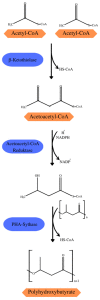Recent Biotechnological Applications of Polyhydroxyalkanoates (PHA) in the Biomedical Sector-A Review
- PMID: 38006129
- PMCID: PMC10675258
- DOI: 10.3390/polym15224405
Recent Biotechnological Applications of Polyhydroxyalkanoates (PHA) in the Biomedical Sector-A Review
Abstract
Petroleum-derived plastics are materials of great importance for the contemporary lifestyle, and are widely used commercially because they are low cost, resistant, malleable, and weightless, in addition to their hydrophobic character. However, some factors that confer the qualities of these materials also cause problems, mainly environmental, associated with their use. The COVID-19 pandemic aggravated these impacts due to the high demand for personal protective equipment and the packaging sector. In this scenario, bioplastics are environmentally positive alternatives to these plastics due to their applicability in several areas ranging from packaging, to biomedicine, to agriculture. Polyhydroxyalkanoates (PHAs) are biodegradable biopolymers usually produced by microorganisms as an energy reserve. Their structural variability provides a wide range of applications, making them a viable option to replace polluting materials. PHAs can be applied in various biotechnology sectors, such as producing drug carriers and scaffolds for tissue engineering. This review aimed to survey works published in the last five years on the study and biotechnological application of PHAs in the biomedical sector, exploring the versatility and advantages of their use and helping to understand how to enhance their application.
Keywords: biodegradable; biomedical; drug carrier; plastics; polyhydroxyalkanoate; scaffolds.
Conflict of interest statement
The authors declare no conflict of interest.
Figures
References
-
- Vimal K.E.K., Mathiyazhagan K., Agarwal V., Luthra S., Kirupanandan S. Analysis of Barriers That Impede the Elimination of Single-Use Plastic in Developing Economy Context. J. Clean. Prod. 2020;272:122629. doi: 10.1016/j.jclepro.2020.122629. - DOI
-
- Okoffo E.D., Donner E., McGrath S.P., Tscharke B.J., O’Brien J.W., O’Brien S., Ribeiro F., Burrows S.D., Toapanta T., Rauert C., et al. Plastics in Biosolids from 1950 to 2016: A Function of Global Plastic Production and Consumption. Water Res. 2021;201:117367. doi: 10.1016/j.watres.2021.117367. - DOI - PubMed
Publication types
Grants and funding
LinkOut - more resources
Full Text Sources
Molecular Biology Databases






